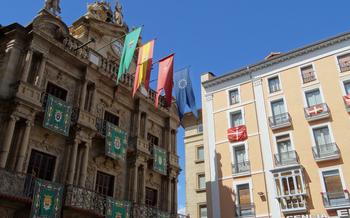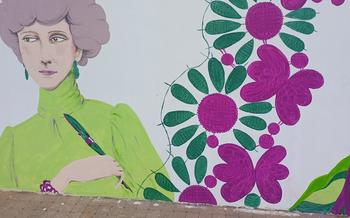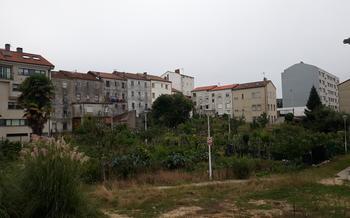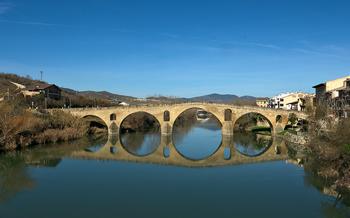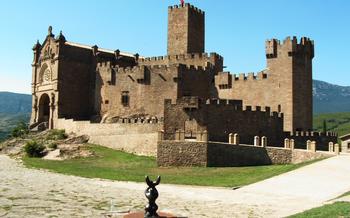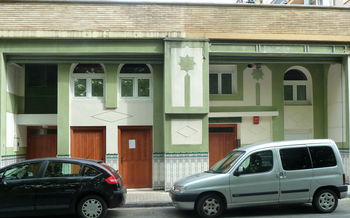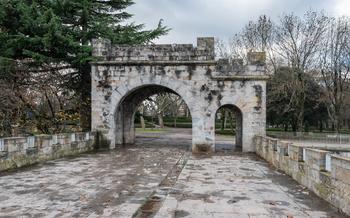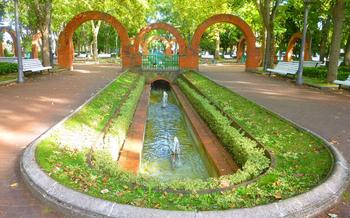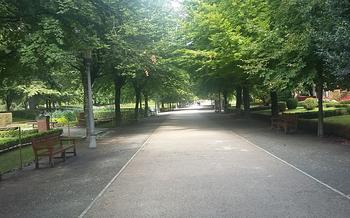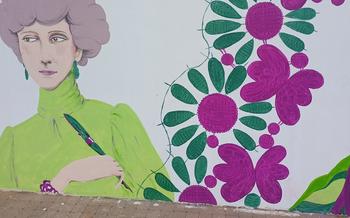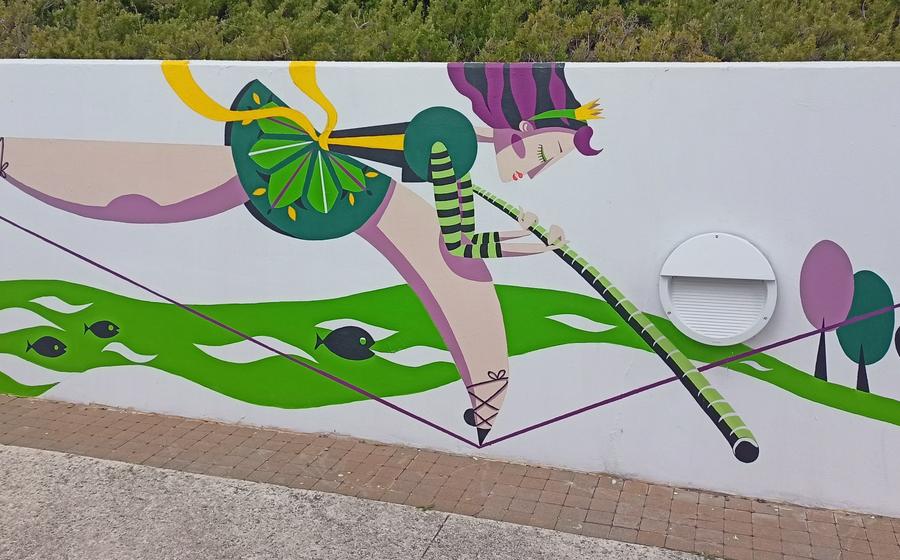
Javieradas Pilgrimage Route
- Pilgrimage Route to Javier Castle
- Exploring Javier Castle
- Paying Homage at the Basilica of Javier
- Immerse in the Vibrant Town of Javier
- Discover the Scenic Landscapes
- Attend the Javierada Pilgrimage Festival
- Pilgrimage Route Transportation
- Pilgrimage Route Essentials
- Spiritual Reflections Along the Way
- Local Cuisine and Gastronomy
- Pilgrimage Route History and Background
- Pilgrimage Route Challenges and Rewards
- Pilgrimage Route Photography Tips
- Insider Tip: Embrace the Local Culture
Pilgrimage Route to Javier Castle
The Javieradas Pilgrimage Route is a historic and spiritual journey that leads to the Javier Castle, the birthplace of Saint Francis Xavier, a prominent Jesuit missionary. This route holds immense religious and cultural significance for pilgrims and history enthusiasts alike.
The pilgrimage route covers a distance of approximately 70 kilometers and can be completed in three to four days. It begins in the town of Sangüesa and takes pilgrims through picturesque landscapes, charming villages, and ancient landmarks. Along the way, pilgrims can immerse themselves in the region's rich history, culture, and spirituality.
Route Highlights:
- Sangüesa: The starting point of the pilgrimage, known for its well-preserved medieval architecture.
- Monastery of Leyre: A historic Benedictine monastery founded in the 8th century, offering stunning views of the surrounding countryside.
- Javier Castle: The ancestral home of Saint Francis Xavier, featuring a magnificent Renaissance-style façade and a museum dedicated to his life and work.
- Basilica of Javier: A grand 17th-century basilica dedicated to Saint Francis Xavier, attracting pilgrims from around the world.
Best Time to Visit:
The best time to embark on the Javieradas Pilgrimage Route is during the spring (April-May) or autumn (September-October) when the weather is pleasant and ideal for walking. During this time, pilgrims can enjoy the vibrant colors of nature and avoid the extreme heat of summer and the cold of winter.
Exploring Javier Castle
Javier Castle, a magnificent 10th-century fortress, stands as a testament to the region's rich history. Its strategic location atop a hill overlooking the town of Javier and the surrounding countryside made it a crucial defensive stronghold during medieval times. Explore the castle's well-preserved fortifications, including its imposing towers and ramparts, which offer breathtaking panoramic views of the surrounding landscapes.
As you wander through the castle's interior, admire its architectural features, such as the Gothic-style windows, intricate carvings, and grand halls that exude an aura of grandeur. Delve into the castle's fascinating history at the Xavier Museum, which houses a collection of artifacts, documents, and exhibits that narrate the castle's role in battles, sieges, and the lives of its former inhabitants.
Take advantage of the guided tours offered at the castle, which provide insights into the castle's history, architecture, and its significance as a symbol of Navarrese heritage. These tours bring the castle's stories to life, allowing visitors to experience the grandeur of this historic monument.
Paying Homage at the Basilica of Javier
Standing tall and majestic in the heart of Javier, the Basilica of Javier is an architectural masterpiece that draws pilgrims from around the world. Dedicated to Saint Francis Xavier, the patron saint of Navarre, the basilica holds immense spiritual and historical significance.
The basilica's awe-inspiring facade, adorned with intricate carvings and sculptures, sets the tone for the grandeur that awaits within. As you step inside, the sheer scale and splendor of the interior will leave you in awe. The soaring ceilings, supported by graceful columns, create a sense of spaciousness and tranquility.
The high altar, a focal point of the basilica, is an elaborate work of art, featuring intricate carvings, gilded embellishments, and a stunning altarpiece depicting scenes from the life of Saint Francis Xavier. The basilica also houses several chapels, each with its unique charm and significance, dedicated to various saints and offering a serene space for prayer and reflection.
One of the highlights of the basilica is the crypt, where the remains of Saint Francis Xavier lie interred. Pilgrims from far and wide come to pay homage to the saint, seeking his intercession and inspiration. The crypt exudes a palpable sense of reverence and spirituality, inviting visitors to connect with the saint's legacy and seek his guidance.
Throughout the year, the basilica hosts various religious ceremonies and events, including masses, processions, and special pilgrimages. These events draw large crowds of devotees who come together to celebrate their faith and honor Saint Francis Xavier. Participating in these ceremonies offers a glimpse into the rich spiritual traditions of the region and allows pilgrims to connect with the local community.
Immerse in the Vibrant Town of Javier
Javier, a town nestled amidst the foothills of the Pyrenees, offers an immersive experience into the local culture and traditions of the region. The vibrant town square, lined with charming cafes and artisanal shops, invites visitors to linger and soak up the atmosphere. The local cuisine, influenced by Spanish and Basque flavors, showcases a delectable array of dishes, from hearty stews to fresh seafood specialties.
A visit to the Javier Market is a must for those seeking unique souvenirs and local delicacies. From handmade crafts to locally produced cheeses and wines, the market offers a glimpse into the town's rich culinary heritage.
For those seeking a more immersive experience, cooking classes and workshops provide an opportunity to learn the secrets behind traditional Navarrese dishes. Participants can try their hand at preparing classic dishes such as "migas", a savory breadcrumb dish, or "calderete", a hearty lamb stew.
When the sun sets, Javier transforms into a lively hub of activity. Locals gather at the town square, where traditional Basque music and dance performances take place. Visitors are welcome to join in the festivities, immersing themselves in the vibrant culture of this charming town.
Discover the Scenic Landscapes
The Javieradas Pilgrimage Route unfolds amidst stunning natural landscapes that captivate the senses. As you journey towards Javier Castle, you'll traverse picturesque countryside, verdant valleys, and rugged mountain ranges. The region boasts a diverse tapestry of ecosystems, from lush forests to tranquil rivers and glistening lakes.
Embrace the opportunity to immerse yourself in the beauty of nature by embarking on one of the many hiking or biking trails that crisscross the region. These paths wind through enchanting forests, offering glimpses of hidden waterfalls, secluded clearings, and breathtaking vistas. Along the way, keep an eye out for the region's rich wildlife, including soaring birds of prey, nimble squirrels, and graceful deer.
Several panoramic viewpoints dot the route, inviting you to pause and soak in the awe-inspiring scenery. From these vantage points, you can gaze upon rolling hills, patchwork fields, and distant mountain peaks. The sunsets and sunrises along the route are particularly magical, casting a warm glow over the landscape and creating a truly unforgettable experience.
Attend the Javierada Pilgrimage Festival
The Javierada Pilgrimage Festival is a remarkable event that takes place annually in Javier, drawing thousands of pilgrims and visitors from around the world. This vibrant celebration honors Saint Francis Xavier, the patron saint of Navarre, and showcases the town's rich cultural and religious heritage.
The festival begins with a solemn procession, where a statue of Saint Francis Xavier is carried through the streets of Javier, accompanied by traditional music and dance performances. Pilgrims and locals alike join the procession, creating a vibrant and colorful atmosphere.
Throughout the festival, visitors can enjoy a variety of cultural events, including concerts, theater performances, and traditional Basque sports competitions. There are also numerous food stalls offering local delicacies, as well as artisanal markets showcasing the region's traditional crafts.
The highlight of the festival is the pilgrimage itself, which takes place on March 12th, the feast day of Saint Francis Xavier. Pilgrims from all over the world gather in Javier to walk the Javieradas Pilgrimage Route, a 70-kilometer journey that begins in Sangüesa and ends at Javier Castle.
Participating in the Javierada Pilgrimage Festival is a unique and enriching experience that allows visitors to immerse themselves in the local culture and traditions, while also celebrating the life and legacy of Saint Francis Xavier. It is a journey that combines spirituality, history, and vibrant cultural expression, leaving a lasting impression on all who participate.
Pilgrimage Route Transportation
Navigating the Javieradas Pilgrimage Route requires careful planning regarding transportation. Several options are available to suit different preferences and budgets.
Public Transportation: Public transportation is a convenient and economical choice for pilgrims. Buses and trains connect major cities and towns along the route, allowing for easy access to starting points. It's advisable to check schedules and routes in advance to ensure smooth connections.
Renting a Car or Bicycle: For those who prefer independence and flexibility, renting a car or bicycle is an excellent option. This allows pilgrims to set their own pace, explore at their leisure, and easily reach smaller villages and attractions. Bike rentals are particularly popular, as cycling is a great way to immerse in the natural beauty of the region.
Joining Organized Tours: For a hassle-free experience, organized tours offer a comprehensive package that includes transportation, accommodation, and guided visits. These tours often cater to specific interests, such as history, culture, or spirituality, and provide a wealth of information and insights.
Airport Transfers: If arriving by plane, pre-arranging airport transfers to the starting point of the pilgrimage is recommended. This ensures a smooth and convenient transition from the airport to the trailhead. Many hotels and tour operators offer airport transfer services, making it easy to kick-start the pilgrimage without any hassles.
Pilgrimage Route Essentials
Whether you're a seasoned pilgrim or embarking on your first Javieradas pilgrimage, proper preparation is key. Here are some essential tips to ensure a smooth and fulfilling journey:
Packing List for the Pilgrimage:
-
Footwear: Comfortable and well-broken-in hiking shoes or boots are a must. Blisters are a common pilgrim woe, so make sure your footwear fits snugly but doesn't pinch.
-
Clothing: Pack layers to accommodate changing weather conditions. Include moisture-wicking base layers, a fleece or sweater, and a rain jacket.
-
Backpack: Choose a lightweight backpack with enough space for your essentials. A 30-liter backpack is a good starting point.
-
Sleeping Bag and Mat: If you plan on staying in pilgrim hostels or camping along the way, bring a lightweight sleeping bag and a sleeping mat.
-
Other Essentials: Don't forget a hat, sunglasses, sunscreen, a water bottle, a first-aid kit, and a small flashlight.
Required Documents and Permits:
-
Pilgrim's Credential: Obtain a pilgrim's credential, or "credencial," from your local parish or the pilgrim's office in Javier. This document serves as proof of your pilgrimage and allows you to collect stamps along the way.
-
Passport or ID: Bring your passport or a valid form of identification. You may need it for accommodation, transportation, or crossing borders.
Health and Safety Precautions:
-
Vaccinations: Make sure you are up-to-date on your vaccinations, especially if you're traveling from outside of Europe.
-
Insurance: Consider purchasing travel insurance to cover any unexpected medical expenses or emergencies.
-
Sun Protection: The Spanish sun can be intense, so be diligent about applying sunscreen and wearing protective clothing.
Pilgrimage Etiquette:
-
Respectful Behavior: Remember that the pilgrimage is a spiritual journey for many. Be respectful of other pilgrims and the local communities you pass through.
-
Noise Level: Keep noise to a minimum, especially in pilgrim hostels and churches.
-
Sharing the Path: Be mindful of other pilgrims and cyclists when walking or cycling on the route.
Spiritual Reflections Along the Way
Pilgrimage to Javier Castle offers a unique opportunity for spiritual growth and introspection. As you traverse the ancient paths, surrounded by breathtaking landscapes, you'll find yourself connecting with nature and your inner self. The journey encourages you to reflect on your life, your beliefs, and your relationship with the divine. Along the way, you'll encounter fellow pilgrims from diverse backgrounds, fostering a sense of community and shared purpose. Conversations with fellow pilgrims and interactions with locals can provide profound insights and perspectives. The pilgrimage culminates in the Basilica of Javier, where you can pay homage to Saint Francis Xavier and seek spiritual renewal. The serene ambiance of the basilica invites you to find inner peace and deepen your connection with your faith. Whether you're a seasoned pilgrim or embarking on your first spiritual journey, the Javieradas Pilgrimage Route promises a transformative experience that will leave a lasting impact on your soul.
Local Cuisine and Gastronomy
Navarra's cuisine is a testament to the region's rich history and cultural influences. From hearty stews to fresh seasonal produce, the local gastronomy is a delightful journey for the taste buds.
- Traditional Dishes:
- Savor the iconic cocido navarro, a hearty stew featuring chickpeas, vegetables, and succulent meats.
- Indulge in asparagus from Navarra, renowned for its delicate flavor and nutritional value.
-
Try migas de pastor, a rustic dish of fried breadcrumbs with chorizo, bacon, and eggs.
-
Must-Try Culinary Experiences:
- Visit local markets to sample fresh seasonal fruits, vegetables, and artisanal cheeses.
- Join a cooking class or workshop to learn the secrets of traditional Navarran cuisine.
-
Dine at renowned restaurants that showcase the region's culinary heritage with a modern twist.
-
Local Markets and Restaurants:
- Explore the bustling Mercado de Santo Domingo in Pamplona for a vibrant array of local produce and delicacies.
-
Discover hidden gems in the charming villages of Javier and Sangüesa, where family-run restaurants serve authentic Navarran dishes.
-
Cooking Classes and Workshops:
- Enhance your culinary skills with a hands-on cooking class, learning to prepare traditional dishes like pisto manchego or tortilla de patatas.
- Participate in a wine tasting session to explore the region's renowned wines, such as the rosés of Navarra.
Pilgrimage Route History and Background
The Javieradas Pilgrimage Route has a rich and storied history, deeply intertwined with religious devotion, cultural traditions, and the life of Saint Francis Xavier. Its origins can be traced back to the 16th century when pilgrims began traveling to Javier Castle, the birthplace of Saint Francis Xavier, to seek spiritual guidance and pay homage to his legacy. Over the years, the pilgrimage route gained prominence as a symbol of faith and spirituality, attracting thousands of pilgrims from across the globe.
Historical events and milestones have shaped the pilgrimage route's significance. In the 17th century, the castle was transformed into a Jesuit college, further enhancing its religious importance. The canonization of Saint Francis Xavier in 1622 solidified the route's status as a major pilgrimage destination. Throughout the centuries, the pilgrimage has been influenced by cultural and religious factors, blending Christian traditions with local customs and beliefs.
The role of Saint Francis Xavier in the pilgrimage's history is paramount. Born in Javier Castle in 1506, he became a renowned Jesuit missionary, traveling extensively throughout Asia and spreading the teachings of Christianity. His devotion and missionary work inspired countless individuals to undertake the pilgrimage to his birthplace, seeking spiritual connection and guidance.
The Javieradas Pilgrimage Route stands as a testament to the enduring power of faith, the legacy of Saint Francis Xavier, and the cultural and religious traditions that have shaped its history.
Pilgrimage Route Challenges and Rewards
Undertaking the Javieradas Pilgrimage Route presents both physical and mental challenges that test the limits of determination and resilience. The journey demands endurance, as pilgrims cover long distances on foot, often navigating uneven terrain and unpredictable weather conditions. The physical exertion can be demanding, requiring a strong body and unwavering spirit. However, the challenges are not limited to the physical realm. Pilgrims must also contend with mental and emotional hurdles, such as moments of doubt, fatigue, and loneliness. Overcoming these obstacles requires inner strength, resilience, and a deep sense of purpose. The rewards of the pilgrimage, however, far outweigh the challenges. The sense of accomplishment upon reaching Javier Castle is immense, and the spiritual growth and personal transformation experienced along the way are profound. Pilgrims return home with a renewed sense of purpose, a deeper connection with their faith, and a newfound appreciation for life's simple pleasures. The pilgrimage serves as a reminder that sometimes the most rewarding journeys are those that push us beyond our limits and help us discover our inner strength.
Pilgrimage Route Photography Tips
Documenting your Javieradas pilgrimage journey through photography is a wonderful way to preserve memories and share the experience with others. Here are some tips to help you capture the essence of your pilgrimage:
-
Embrace Natural Light: The golden hours of dawn and dusk offer the most flattering light for photography. Take advantage of these times to capture the beauty of the landscapes and landmarks along the route.
-
Tell a Story: Your photos should tell a visual narrative of your pilgrimage. Capture candid moments of fellow pilgrims, interactions with locals, and the stunning scenery you encounter along the way.
-
Experiment with Perspectives: Don't just stick to standard eye-level shots. Try different angles and perspectives to add depth and interest to your images.
-
Capture Details: Pay attention to the small details that make your pilgrimage unique, such as the medieval architecture, traditional costumes, or religious symbols. These details can help convey the cultural and spiritual significance of your journey.
-
Share Your Story: Once you've returned home, share your pilgrimage story through your photographs. Create a photo album, blog post, or social media gallery to inspire others to embark on their own pilgrimage.
Insider Tip: Embrace the Local Culture
One of the most rewarding aspects of any pilgrimage is the opportunity to immerse oneself in the local culture. In Javier, this means embracing the warm and welcoming nature of the locals, who are proud to share their traditions and heritage with visitors. Make an effort to learn a few basic Spanish phrases to show your respect and willingness to engage with them. Be mindful of local customs and traditions, such as greeting people with a handshake or a kiss on both cheeks. Support the local economy by shopping at local markets and dining at family-run restaurants. By embracing the local culture, you'll not only enhance your pilgrimage experience but also contribute to the preservation of this vibrant community.
